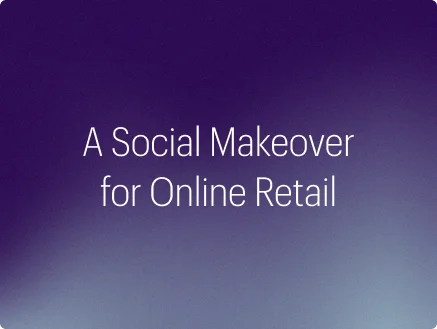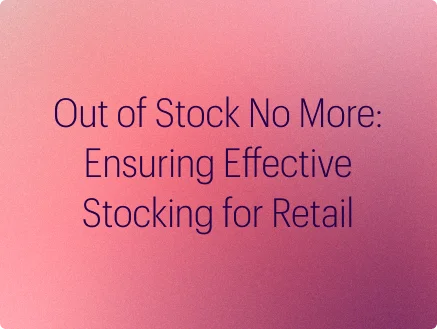Retail has taken a decidedly digital turn in the past few years – we’ve seen the pandemic put in motion a move away from purely brick-and-mortar stores, investments in omnichannel strategies, and the adoption of AI & ML in the retail space. Amidst this sea of changes, mobile and website applications have emerged as a vital lifeline for retailers: enabling direct interactions with consumers, creating new revenue streams, and boosting brand relevance in times when disruptions have characterized consumer behavior and business models. In fact, figures from a study conducted in 2021 showed that 72% of respondents preferred apps over website purchases or in-store shopping [1], marking convenience and speed as the new hallmarks of the retail experience.
Several businesses have been able to rise to this occasion, transforming themselves using the latest technologies, ranging from hyper-customization to contactless shopping experiences. Let’s take a look at the five tech revolutions that are currently redefining the retail industry of tomorrow.
1. Improving customer engagement and monetizing touchpoints: QR codes, Bluetooth beacons, and digital signages
While QR codes are perhaps the simplest form of technology for any business to implement, they offer a disproportionate benefit: rich customer information to bolster shopping experiences and monetize touchpoints including displays and packaging.
Now an integral part of most smartphones, QR codes are easily accessible and can provide detailed product information (including regarding harvesting, sourcing, and delivery) and even recipe suggestions [2]. This becomes particularly important with the mass move towards online retail presences in the past two years—we’ve seen that detailed information on products and greater variety have become essential differentiators for retail brands and D2C aspirants. In fact, to meet its objective of customer engagement and improved brand relevance, a major Dutch retailer integrated blockchain solutions and QR codes into its mobile applications, allowing customers to trace coffee products back to their farms [3].
QR codes also offer convenience in implementation at a variety of touchpoints: for instance, a British clothing retailer uses QR codes in its displays and clothing rails, allowing for immersive storytelling around each of its products. With its application within WeChat further allowing for appointment booking, sharing user-generated content (UGC), and even turning virtual in-app currency into animal characters, brand recognition and user satisfaction have been boosted through gamification strategies [4]. The use of AI in conjunction with QR codes can take the customer experience one step further, enabling, for example, customizing product information as per users’ needs, enabling targeted recommendations, and analyzing customer queries and actions to build comprehensive customer profiles.
Further, Bluetooth applications are also bolstering the contactless shopping experience, enabling instant connectivity while offering a rich stream of data on consumer behavior. Through the use of Bluetooth low energy (BLE) beacons or sensors located across a store, smartphones and other connected devices can be leveraged to send personalized notifications, deals, and offers to customers at different points in the store as well as run promotional events. For instance, a major retailer uses beacons to create maps and routes for customers, helping them locate items on their shopping lists [5].
Further, deploying effective proximity marketing strategies, another major lifestyle retailer used beacons to boost the adoption of its loyalty program, sending personalized offers to customers who accessed the store’s social media channels through their phones [6].
In addition, digital signage – including in-store digital and touch screen displays as well as digital-out-of-home (DOOH) devices – can be another major avenue for retailers to explore, enabling personalized offers, dynamic pricing and promotions, and upselling and cross-selling based on real-time information [7].
Leveraging analytics for these multiple touchpoints can not only streamline these processes but also offer rich information on the products that are performing well, analyze shelves to determine optimal product placement, and tailor the retail experience for each individual customer.
2. Going contactless: Taking the long view on customer needs
The proliferation of digital wallets based on touch-, voice-, facial recognition and even blockchain technology is one of the major indications that contactless shopping is going big. From online orders to Buy Online, Pickup In Store (BOPIS), Buy Online, Return In Store (BORIS), and contactless scanning in stores, options abound and are here to stay.
However, this is a trend that was in the making long before the pandemic: A major American MNC, considered a pioneer in this space, launched stores with entirely automated payment, buying, and checkout processes. They integrated deep learning, computer vision, and sensor fusion technology to successfully reduce staffing requirements as well as wait times for customers.
With 78% of consumers surveyed in a study now mentioning that they have adopted new shopping habits following the pandemic, preferring e-commerce and more contactless payments [8], preparing for long-term contactless technology adoption has become essential to business continuity.
There are several areas where retail touchpoints can be made contactless: for instance, through AI-enabled facial/voice/iris recognition, directly linked digital wallets (replacing current swipe and tap payment methods), and contactless store pick-up/service through AI-augmented robots. In connection with the latter, a Chinese retail giant integrated food ordering options into its mobile apps, with robots then used to transfer items from shelves to the kitchen and also deliver meals within stores [9]. These are one of the many use cases for robots in retail, enhancing customer experience while ensuring safety and convenience.
Adding to the revolution in contactless experiences are also chatbots, which can effectively answer a range of customer queries, offer personalized recommendations, gather data on customers, and aid customer service executives in better understanding questions and concerns. With recent advances in Natural Language Generation (NLG), which uses a combination of AI, deep learning, and machine learning, functionalities such as storytelling around data, advanced text prediction and recommendations, and even the formulation of responses, summaries, and articles [10] have become possible. Such technology has also become the basis for chatbots with distinct personalities—which are increasingly becoming first-line respondents in retail scenarios. Having such functionalities baked into mobile and web applications, and popularizing them using incentives such as loyalty points and coupons, retailers can effectively cater to changing customer requirements.
3. The immersive experience: Key to customer retention
Offering immersive and interactive mobile experiences has come at a boon in times where traffic to physical stores has been limited across geographies, and with people preferring e-commerce to physical shopping. Although, in cases where customers are likely to prefer physical shopping, and interact with products themselves before making decision, in-store digital innovations become key to high conversion rates. For instance, a retailer that specializes in winter clothing created Cold Rooms [11], where customers could try out coats in temperature-controlled settings—including snow, wind, and temperatures in the negative—to help them test out products. Despite the pandemic and lockdowns, revenues increased 15.4% in 2020 following the introduction of Cold Rooms [12] —the takeaway here being the importance of highlighting not just products but their utility is well.
Tech-enabled innovations, including interactive displays and AR/VR-based content, are now bringing the store experience straight to customers’ homes. For instance, a makeup retailer immediately scaled its virtual try-on app during the pandemic, leveraging the expertise of 80 in-store associates as well as AI to enable skin analysis, makeup trials, and virtual accessorizing. By further expanding virtual inventory, the business saw improved traction, with customers using the app exhibiting 10% higher average order values than others. [13]
Further, smart mirrors are another popular technology that is making waves in improving customer experiences, helping customers try out various products before purchase, providing information on offers and promotions, as well as providing easy access to detailed inventory information. For instance, a British multinational retailer used ‘magic mirrors’ in their stores, with AI helping capture people’s dimensions and positions and then helping them “try” on various clothes virtually. With the process controlled by hand gestures, the smart mirrors presented a novel shopping experience as well [14].
Using mobile and web platforms to tie back to the brick-and-mortar store is also another viable option in the long run: for instance, a jeweler based in Shenzen, China, pivoted to an e-commerce model during the pandemic, live streaming their store—with store associates explaining the features of products in real time—such that information could be disseminated across larger geographies and even the entire country. With the mobile-app-based platform doubling as a virtual warehouse, the business was able to boost brand recognition and sales despite limited physical store operations [15].
4. The personal touch: Customized and built-to-order products
With mass personalization becoming widespread in retail, we’re seeing customized products emerging as a natural consequence of this paradigm shift. With interactive interfaces at various touchpoints, where customers can choose from multiple options, personalization can be effectively made reality, all while cutting down on the tangible costs of returns and replacements as well as the intangible cost of customer dissatisfaction. Layered over applications where consumers can input their requirements, AI can help examine behavior and preferences to intuitively offer a range of options. For example, a major footwear retailer, in addition to immersive technology and instant checkouts, provided customization as a key offering in its New York flagship store [16]. With AI recommending options from special sneaker sizes and colors to material options and special prints, the possibilities of customization are endless.
Further, with the rise of D2C brands, and the increasing popularity of customization for all product types, the scope for tailored products must necessarily extend to the entirety of the supply chain to ensure greater agility and response to market demand. For instance, with a group of retail companies having built a completely made-to-order manufacturing system that works with eco-friendly fabrics [17], partner clothing brands can place orders through an automated supply chain and have items directly delivered to customers. With analytics helping unify the entire supply chain and giving customers control over, and insights into, products using mobile and web applications, retail businesses can effectively achieve personalization at scale.
5. Voice and visual searches: Scaling consumer bases with smart functionalities
With voice commerce sales expected to reach $40 billion in the US by 2022 [18], the role of this advanced tech in boosting the utility of retail applications is clear. With Natural Language Processing (NLP) capabilities driving voice recognition and translation across devices and platforms, and with the increasing popularity of smart home assistants, this technology can enable a range of conveniences for retail shoppers, including information in their own languages, ease of access to those with different and special needs, and the automation of time-consuming processes. For instance, AI can help effectively recommend products, aid with query resolution, and automate product orders and delivery [19], reducing the time and effort required for daily shopping activities.
Further, retail leaders are also making visual searches an integral part of online shopping, turning user input into product recommendations to make shopping more flexible and convenient. With AI&ML closely mapping visual search items to similar products, and mining visual-rich social media platforms including Pinterest and Instagram, consumer interaction, consumption, and traffic at multiple retail touchpoints can be optimized [20]. Investing in advanced voice and search capabilities for retail applications would be significant in improving accessibility to a wider number of users and growing consumer bases over time.
With the great strides currently being made in digital technology, retailers’ ability to effectively respond to market changes and shifting consumer preferences has been significantly enhanced as well. With consumers now looking to innovative, informational, and immersive retail experiences, AI can enable businesses to tap into rich customer data, optimize various retail touchpoints, and design novel omnichannel strategies that, while innovating on offerings and boosting brand relevance, can ensure customer engagement and satisfaction in the long run.
Bibliography
1. “Realize Retail App’s Potential to Build Loyalty – Think with Google Apac.” Google. Accessed April 3, 2022. https://www.thinkwithgoogle.com/intl/en-apac/marketing-strategies/app-and-mobile/retail-mobile-app-potential/.
2. Saiidi, Uptin. “Inside Alibaba’s New Kind of Superstore: Robots, Apps and Overhead Conveyor Belts.” CNBC, September 3, 2018. https://www.cnbc.com/2018/08/30/inside-hema-alibabas-new-kind-of-superstore-robots-apps-and-more.html.
3. Insights, Ledger. “Hema Partners with Farmer Connect for Blockchain Coffee Traceability.” Ledger Insights – blockchain for enterprise, March 31, 2021. https://www.ledgerinsights.com/hema-farmer-connect-blockchain-coffee-traceability/.
4. Sharbatian, Anne-Lise. “Council Post: The Future of Fashion and Gaming: E-Commerce.” Forbes, March 16, 2021. https://www.forbes.com/sites/forbestechcouncil/2021/03/17/the-future-of-fashion-and-gaming-e-commerce/?sh=2b8029143be3.
5. Perez, Sarah. “Target Rolls out Bluetooth Beacon Technology in Stores to Power New Indoor Maps in Its App.” TechCrunch, April 22, 2019. https://techcrunch.com/2017/09/20/target-rolls-out-bluetooth-beacon-technology-in-stores-to-power-new-indoor-maps-in-its-app/.
6.”Urban outfitters to lure back key market with beacons”. Powerretail. Accessed April 3, 2022. https://powerretail.com.au/news/urban-outfitters-to-lure-back-key-market-with-beacons/.
7. “6 Ways IOT Is Transforming Retail as We Know It.” Plug and Play Tech Center. Accessed October 27, 2023. https://www.plugandplaytechcenter.com/resources/6-ways-iot-transforming-retail-we-know-it/.
8. Laura.safran. “Contactless Commerce Not Just a COVID-19 Trend: Why Swipe Days Are Numbered.” TechCrunch, August 3, 2020. https://techcrunch.com/sponsor/visa/contactless-commerce-not-just-covid-19-trend/.
9. Saiidi, Uptin. “Inside Alibaba’s New Kind of Superstore: Robots, Apps and Overhead Conveyor Belts.” CNBC, September 3, 2018. https://www.cnbc.com/2018/08/30/inside-hema-alibabas-new-kind-of-superstore-robots-apps-and-more.html.
10. Kaput, Mike. “Natural Language Generation (NLG): Everything You Need to Know.” Marketing AI Institute, 2022. https://www.marketingaiinstitute.com/blog/the-beginners-guide-to-using-natural-language-generation-to-scale-content-marketing.
11. “Extreme Weather Outerwear | since 1957 | Canada Goose.” Canada Goose. Accessed October 1, 2022. https://www.canadagoose.com/ca/en/home-page.
12. “The 10 Most Innovative Retail Companies of 2021 – Fast Company.” Fast Company. Accessed March 1, 2022. https://www.fastcompany.com/90600263/retail-most-innovative-companies-2021.
13. “The 10 Most Innovative Retail Companies of 2021 – Fast Company.” Fast Company. Accessed March 1, 2022. https://www.fastcompany.com/90600263/retail-most-innovative-companies-2021.
14. “Tesco’s Magic Mirror.” Retail Innovation, May 2, 2013. https://www.retail-innovation.com/tescos-magic-mirror.
15. Lung, Tiffany. “How Chinese Jeweller Ideal Transformed Staff into Live-Streaming KOLs.” Inside Retail Asia, January 6, 2021. https://insideretail.asia/2020/04/07/how-chinese-jeweller-ideal-transformed-staff-into-live-streaming-kols/.
16. “Nike’s News NYC Flagship Is the Face of Living Retail.” About.nike.com, November 14, 2018. https://about.nike.com/en/newsroom/releases/nike-nyc-house-of-innovation-000.
17. Home: One.” Home | ONE. Accessed March 1, 2022. https://www.resonancecompanies.com/.
18. Perez, Sarah. “Voice Shopping Estimated to Hit $40+ Billion across U.S. and U.K. by 2022.” TechCrunch, March 2, 2018. https://techcrunch.com/2018/03/02/voice-shopping-estimated-to-hit-40-billion-across-u-s-and-u-k-by-2022/.
19. Ward, Tom. “Want Walmart to Help You Grocery Shop? With Our New Voice Capabilities, Just Say the Word.” Walmart Corporate News and Information, April 2, 2019. https://corporate.walmart.com/news/2019/04/02/want-walmart-to-help-you-grocery-shop-with-our-new-voice-capabilities-just-say-the-word.
20. “Artificial Intelligence and Chatbots.” Saleculator. Accessed March 1, 2022. https://www.saleculator.com/2021/03/15/artificial-intelligence-and-chatbots/.


